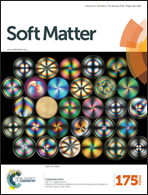Reply to the Comments on “Curvature capillary migration of microspheres” by P. Galatola and A. Würger
Abstract
We have studied microparticle migration on curved fluid interfaces in experiment and derived an expression for the associated capillary energy E for two cases, i.e., pinned contact lines and equilibrium contact lines, which differ from expressions derived by others in the literature. In this article, a particle of radius a makes a disturbance in a large domain characterized by principal radii of curvature R1 and R2. Since a is smaller than all associated geometric and physico-chemical length scales, analysis calls for a singular perturbation approach. We recapitulate these concepts, identify conceptual errors in the Comments about our work, and provide evidence from experiments and simulations that support our view.

 Please wait while we load your content...
Please wait while we load your content...